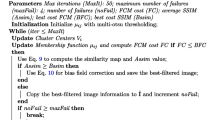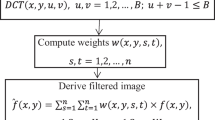Abstract
Brain MR Images corrupted by RF-Inhomogeneity exhibit brightness variations in such a way that a standard Fuzzy C-Means (fcm) segmentation algorithm fails. As a consequence, modified versions of the algorithm can be found in literature, which take into account the artifact. In this work we show that the application of a suitable pre-processing algorithm, already presented by the authors, followed by a standard fcm segmentation achieves good results also. The experimental results ones are compared with those obtained using SPM5, which can be considered the state of the art algorithm oriented to brain segmentation and bias removal.
Preview
Unable to display preview. Download preview PDF.
Similar content being viewed by others
References
Ardizzone, E., Pirrone, R., Gambino, O.: Exponential Entropy Driven HUM on Knee MR Images. In: Proc. of IEEE XXVII Engineering in Medicine and Biology Conference - 4/7 September 2005, Shanghat,China (2005)
Nelder, J.A., Mead, R.: A Simplex Method for Function Minimization. Comput. J. 7, 308–313 (1965)
Perona, P., Malik, J.: Scale-Space and Edge Detection Using Anisotropic Diffusion. IEEE Trans. on Pattern Analysis and Machine Intelligence 12(7), 629–639 (1990)
Smith, S.M.: Fast robust automated brain extraction. Human Brain Mapping 17(3), 143–155 (2002)
Johnston, B., Atkins, M.S., Mackiewich, B., Member, Anderson, M.: Segmentation of Multide Sclerosis Lesions in Intensity Corrected Multispectral MRI. IEEE Transaction On Medical Imaging 15(2) (April 1996)
Ahmed, M.N, Yamany, S.M., Mohamed, N.: A Modified Fuzzy C-Means Algorithm for Bias Field Estimation and Segmentation of MRI Data. IEEE Transactions on Medical Imaging 21, 193–199 (2002)
Guillemaud, R.: Uniformity Correction with Homomorphic filtering on Region of Interest. In: IEEE International Conference on Image Processing. vol. 2, pp. 872–875 (1998)
Axel, L., Costantini, J., Listerud, J.: Intensity Correction in Surface Coil MR Imaging. American Journal on Roentgenology 148, 418–420 (1987)
Jiang, L., Yang, W.: A Modified Fuzzy C-Means Algorithm for Segmentation of Magnetic Resonance Images. In: Sun, C., Talbot, H., Ourselin, S., Editions, A.T. (eds.) Proc. VIIth Digital Image Computing: Techniques and Applications, pp. 225–231 (2003)
Brinkmann, B.H., Manduca, A., Robb, R.A.: Optimized Homomorphic Unsharp Masking for MR Greyscale Inhomogeneity Correction. IEEE Transactions on Medical Imaging. 17, 161–171 (1998)
Likar, B., Viergever, M.A., Pernus, F.: Retrospective Correction of MR Intensity Inhomogeneity by Information Minimization. IEEE Transactions on Medical Imaging 20, 1398–1410 (2001)
Pham, D.L., Prince, J.L.: Adaptive Fuzzy Segmentation of Magnetic Resonance Images. IEEE Transactions on Medical Imaging 18(9), 737–752 (1999)
Pham, D.L., Prince, J.L.: An Adaptive Fuzzy C-Means Algorithm for Image Segmentation in the Presence of Intensity Inhomogeneities. Pattern Recognition Letters 20(1), 57–68 (1999)
Kwan, R.K.S., Evans, A.C., Pike, G.B.: MRI simulation-based evaluation of image-processing and classification methods. IEEE Transactions on Medical Imaging. 18(11), 1085–1097 (1999)
Kwan, R.K.S., Evans, A.C., Pike, G.B.: An Extensible MRI Simulator for Post-Processing Evaluation. In: Höhne, K.H., Kikinis, R. (eds.) VBC 1996. LNCS, vol. 1131, pp. 135–140. Springer, Heidelberg (1996)
Author information
Authors and Affiliations
Editor information
Rights and permissions
Copyright information
© 2007 Springer-Verlag Berlin Heidelberg
About this paper
Cite this paper
Ardizzone, E., Pirrone, R., Gambino, O. (2007). Fuzzy C-Means Segmentation on Brain MR Slices Corrupted by RF-Inhomogeneity. In: Masulli, F., Mitra, S., Pasi, G. (eds) Applications of Fuzzy Sets Theory. WILF 2007. Lecture Notes in Computer Science(), vol 4578. Springer, Berlin, Heidelberg. https://doi.org/10.1007/978-3-540-73400-0_48
Download citation
DOI: https://doi.org/10.1007/978-3-540-73400-0_48
Publisher Name: Springer, Berlin, Heidelberg
Print ISBN: 978-3-540-73399-7
Online ISBN: 978-3-540-73400-0
eBook Packages: Computer ScienceComputer Science (R0)




